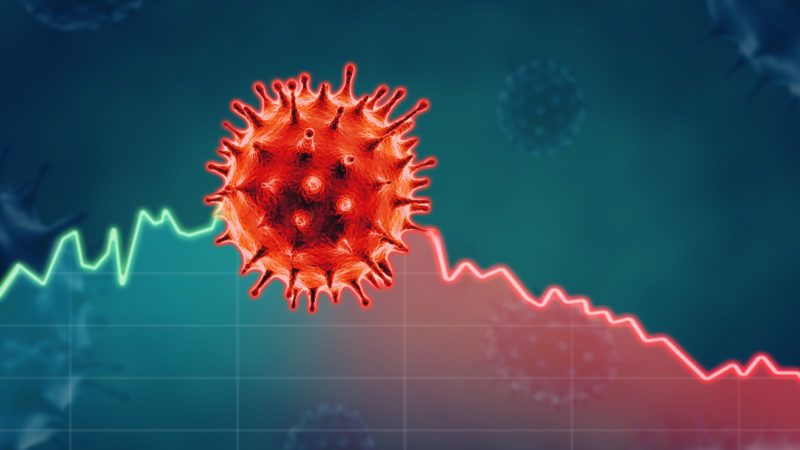Newly Identified COVID-19 Cases Are Falling in Sunbelt States Where They Spiked This Summer
The trend means we should see declining daily deaths in the coming weeks.

The summer surge in COVID-19 infections reported by several Sunbelt states, which has driven a nationwide rise in cases and deaths, seems to be subsiding. Recent data indicate that daily new cases, after rising dramatically in June and July, are either declining or leveling off in Arizona, California, Florida, Georgia, and Texas.
According to Worldometer's tallies, which are based on numbers from state and local health departments, the seven-day average of newly reported infections in Arizona fell from a peak of nearly 3,700 on July 7 to less than 2,000 yesterday. Three other Sunbelt states also have seen substantial declines in their seven-day averages: from about 10,300 on July 25 to about 6,700 on August 5 in California*; from about 11,900 on July 17 to about 7,300 on August 5 in Florida; and from about 10,100 on July 15 to about 8,300 on August 5 in Texas. In Georgia, meanwhile, the seven-day average peaked around 3,700 on July 24 and has since fallen slightly to about 3,300 as of yesterday.
Consistent with those trends, independent data scientist Youyang Gu's model shows the COVID-19 reproductive number—the number of people infected by the average carrier—falling below one in Arizona, California, Florida, Georgia, and Texas. A reproductive number of less than one indicates a waning epidemic.
Lockdown supporters might surmise that increased government restrictions on social and economic activity explain these positive trends. Florida and Texas, for example, ordered bars to close on June 26 after allowing them to reopen on June 3 and May 22, respectively. Texas Gov. Gregg Abbott also reduced the number of customers restaurants are allowed to serve from 75 percent to 50 percent of capacity. In California, Gov. Gavin Newsom closed bars, zoos, and museums on July 13, when he also banned indoor dining in restaurants.
It is certainly plausible that limiting the options for people to get together, especially indoors in close quarters, would reduce virus transmission. But it is difficult to disentangle the impact of government mandates from the impact of increased voluntary precautions, both of which can be expected in response to spikes in cases.
According to the current "best estimate" from the Centers for Disease Control and Prevention (CDC), about 40 percent of people infected by the COVID-19 virus do not develop symptoms. But among those who do, the CDC says, symptoms generally appear after about five days, although the lag can be as short as two days or as long as 14. Keeping in mind the typical delay between infection and symptoms that might motivate people to seek testing, the downward trends in California, Florida, and Texas, which began two to three weeks after the new rules were imposed, do not fit very well with the hypothesis that government restrictions are driving the decreases. And neither Arizona, where the seven-day average of daily new cases fell by 46 percent from July 7 to August 5, nor Georgia, where cases have declined slightly since late July, imposed new restrictions in response to rising infections.
What about face masks? Newsom imposed a statewide mandate in California on June 18, followed by Abbott in Texas on July 2. But Arizona, Florida, and Georgia have no such rules, although some local governments in those states require face masks in public places. And here, too, it is hard to tell how much impact government policy has, independent of voluntary steps taken by businesses and individuals.
If Californians and Texans are more inclined to wear masks now than they were in June and early July, is that because more businesses are requiring them, because the surge in cases made people more cautious, or because the governor made face coverings mandatory? The timing of the downward trends in California and Texas, which began more than a month after Newsom's mask mandate and two weeks after Abbott's, casts doubt on those orders' effectiveness.
The seven-day average of COVID-19 fatalities has continued to rise in all of these states, as you would expect based on the typical lag between laboratory confirmation and death—about two weeks, per the CDC. But by the same token, the recent declines in newly identified cases should mean fewer deaths in the coming weeks than we otherwise would have seen, which is (relatively) good news. Gu's projections show daily deaths declining in all five states during the next few months.
Daily new cases are also falling nationally, from a seven-day average of about 69,200 on July 25 to less than 60,000 on August 4, while the seven-day average of daily deaths may be leveling off. Gu, who has a good track record of predicting COVID-19 fatalities, is projecting that daily deaths in the United States will decline gradually during the next few months, from about 1,400 on August 4 to about 530 on November 1. He projects a total U.S. death toll of about 227,000 by then, up from about 157,000 yesterday.
*Update: A technical glitch may have made the decline in California's cases look larger than it actually is. The Sacramento Bee reports that the error, which probably began affecting case totals "around last Friday," led to "significant" undercounting, although exactly how significant is unclear. Citing California Health and Human Services Secretary Mark Ghaly, the Bee says "the one- and two-week figures are affected by the recent technical issue to an extent but remain more accurate depictions of COVID-19 activity than single-day totals."


Show Comments (95)